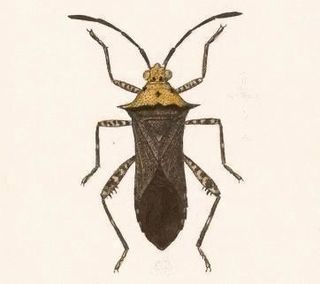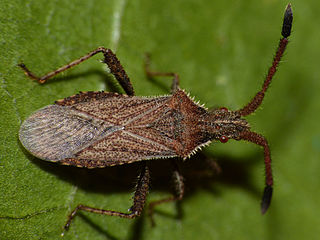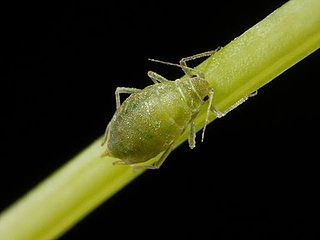
Pentatomidae is a family of insects belonging to the order Hemiptera, generally called shield bugs or stink bugs. Pentatomidae is the largest family in the superfamily Pentatomoidea, and contains around 900 genera and over 4700 species. As hemipterans, the pentatomids have piercing sucking mouthparts, and most are phytophagous, including several species which are severe pests on agricultural crops. However, some species, particularly in the subfamily Asopinae, are predatory and may be considered beneficial.

The Reduviidae is a large cosmopolitan family of the order Hemiptera. Among the Hemiptera and together with the Nabidae almost all species are terrestrial ambush predators; most other predatory Hemiptera are aquatic. The main examples of nonpredatory Reduviidae are some blood-sucking ectoparasites in the subfamily Triatominae. Though spectacular exceptions are known, most members of the family are fairly easily recognizable; they have a relatively narrow neck, sturdy build, and a formidable curved proboscis. Large specimens should be handled with caution, if at all, because they sometimes defend themselves with a very painful stab from the proboscis.

A woodlouse is any crustacean belonging to the suborder Oniscidea within the order Isopoda. They get their name from often being found in old wood, and from louse, a parasitic insect, although woodlice are not insects.

Eumecomera is a genus of false blister beetles in the family Oedemeridae. There are at least three described species in Eumecomera.

Halticotoma is a genus of plant bugs in the family Miridae. There are about six described species in Halticotoma.
Caulotops is a genus of plant bugs in the family Miridae. There are about eight described species in Caulotops.

Zicca is a genus of leaf-footed bugs in the family Coreidae. There are about 19 described species in Zicca.

Trapezonotus is a genus of dirt-colored seed bugs in the family Rhyparochromidae. There are about 19 described species in Trapezonotus.

Thyanta is a genus of stink bugs in the family Pentatomidae. There are about 19 described species in Thyanta.
Barberiella is a genus of plant bugs in the family Miridae. There are at least two described species in Barberiella.

Anisoscelis is a genus of leaf-footed bugs in the family Coreidae. There are about 11 described species in the genus Anisoscelis.

Americodema is a genus of plant bugs in the family Miridae. There are at least two described species in Americodema.

Coriomeris is a genus of leaf-footed bugs in the family Coreidae. There are about 19 described species in Coriomeris.

Amphiareus is a genus of minute pirate bugs belonging to the family Anthocoridae.

Aphelocheirus is a genus of true bugs belonging to the family Aphelocheiridae.

Aulacorthum is a genus of true bugs belonging to the family Aphididae.
Bryocoris is a genus of plant bugs belonging to the family Miridae.

Cavariella is a genus of true bugs belonging to the family Aphididae.

Barytettix is a genus of spur-throated grasshoppers in the family Acrididae. There are about nine described species in Barytettix, found in western Mexico and the southwestern United States.

Metaleptea is a genus of short-horned grasshoppers in the family Acrididae. There are at least two described species in Metaleptea, found in North, Central, and South America.

















